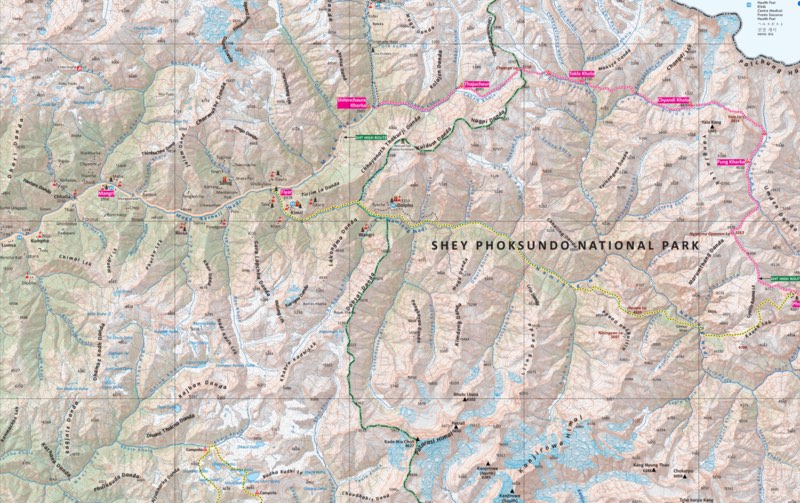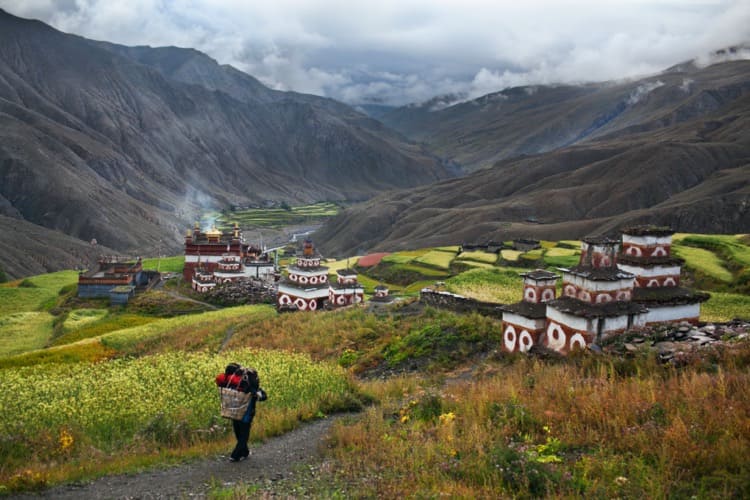Lower Dolpo Circuit Trek
Request a Quote (?)
- Satisfied Client
- Personalised Guide
- Instant Response
Get Instant Response:
+977-9851329446 (Whatsapp)
| Starts at: Dunai | Ends at: Dunai |
| Trek Region: Dolpo | Transport: Flight |
| Duration: 15 Days | Trip Grade: Moderate |
| Max Altitude: 4465 m / 14648 ft (Jeng La Pass) | Accommodation: Camping |
Lower Dolpo Circuit Trek Highlights
- Witness the age-old Bon-Buddhist practices in different monasteries
- Trek to the pristine Shey Phoksundo alongside with an entry to the Phoksundo National Park
- Amazing experience walking in the desert-like rain shadow area of the lower Dolpo region
- Catch the enticing views of Yak Caravan and got to walk on the ancient salt trade route
- Feel enticed by the sight of diverse flora and fauna of the region
The Lower Dolpo Circuit is set in the isolated and remote western region of Dolpo where the landscape and people are more Tibetan than Nepali. This mysterious land has a dry atmosphere and is at high altitude, despite being in ‘lower’ Dolpo. With ever increasing altitudes up to the maximum 5,190m and with days averaging 6 – 7 hours of walking, this two week trek is recommended for experienced and fit hikers. But the rewards are astounding: the crisp, clear blueness of Phoksundo Lake (3,611m); unique flora and fauna; a unique religion; diverse culture; colourful festivals; challenging passes; high snow-covered Kanjirowa Himal peaks and the list goes on!
Much of lower Dolpo falls under the protection of Shey Phoksundo National Park. This has ensured pine, fir and birch forests as well as wildlife such as the elusive snow leopard, rare Himalayan blue sheep, goral, thar, Himalayan black bear, langur and rhesus monkeys, among others, maintain their strength in today’s world.
Isolated villages of people closely related to Tibetans, and ancient monasteries offer a glimpse back in time are another feature of this area. Additionally, this is one of the few remaining places where the Bon Po religion is practiced. Bon Po is similar and yet different from Buddhism – one difference being practitioners walk anti-clockwise round stupas and shrines.
Phoksundo Lake is almost 500 ha in size and was designated a Ramsar site (wetlands of international significance) in 2008. But most probably, people recognise this lake from the film which was made here about, and staring, the people of this area. Known as Caravan in Nepal, the film was called Himalaya on the international stage.
Naturally there is a reason why this area is remote and isolated – difficult and rough, and at times very high and narrow, paths and mountain passes over 5,000m. But for those who have an interest in the Buddhist and Bon Po culture, are excited by windswept scenery interspersed with pine forests and the possibility of sighting rare mammal and medicinal plant species, this is a truly wonderful trek!
Lower Dolpo Circuit Trek Itinerary
Day 1: Kathmandu to Nepalgunj (Flight)
Nepalgunj – 150 m / 492 ft – 50 minutes
Day 2: Nepalgunj to Jhupal (Flight) to Dunai
Dunai – 2850 m / 9350 ft – 4 hrs
Day 3: Dunai to Tarakot
Tarakot – 2543 m / 8343 ft – 6 hrs
Day 4: Tarakot to Laini
Laini – 3160 m / 10367 ft – 6 hrs
Day 5: Laini to Nawar Pani
Nawar Pani – 3545 m / 11630 ft – 5 hrs
Day 6: Nawar Pani to Dho Tarap
Dho Tarap – 4090 m / 13418 ft – 7 hrs
Day 7: Acclimatization Day
Dho Tarap – 4090 m / 13418 ft – 3 hrs
Day 8: Dho Tarap to Numa La Base Camp
Numa La Base Camp – 4440 m / 14566 ft – 6 hrs
Day 9: Numa La Base Camp to Pelung Tang
Pelung Tang – 4465 m / 14648 ft – 6 hrs
Day 10: Pelung Tang to Dajok Tang
Dajok Tang – 4080 m / 13385 ft – 6 hrs
Day 11: Dajok Tang to Ringmo
Ringmo – 3600 m / 11811 ft – 4 hrs
Day 12: Ringmo to Phoksundo Lake
Phoksundo Lake – 3612 m / 11850 ft – 5 hrs
Day 13: Phoksundo Lake to Shyanta
Shyanta – 2520 m / 8267 ft – 4 hrs
Day 14: Shyanta to Jhupal
Jhupal – 2320 m / 7611 ft – 5 hrs
Day 15: Jhupal to Nepalgunj (Flight) to Kathmandu (Flight)
Kathmandu – 1300 m / 4265 ft – 2 hrs
Not satisfied with this Itinerary?
Are you interested on planning custom trip? It only takes 2 minutes.
Includes
- 13 nights accommodation in tents
- 1 night accommodation in Nepalgunj (Hotel Sneha or similar)
- Guide for 15 days
- Cook for 15 days
- Required number of porters for 15 days
- Kathmandu Nepalgunj Kathmandu Flight
- Nepalgunj Jhupal Nepalgunj Flight
- Shey Phoksundo national park permit
- Restricted area permit
- 15 x breakfast, 14 x lunch and 14 x dinner while on the trek
- Lunch and dinner in Nepalgunj
Lower Dolpo Circuit Trek Map

Related Trip in Dolpo Region
Upper Dolpo Circuit Trek | Upper Dolpo to Upper Mustang | Upper Dolpo to Rara Lake | Putha Hiunchuli Expedition
